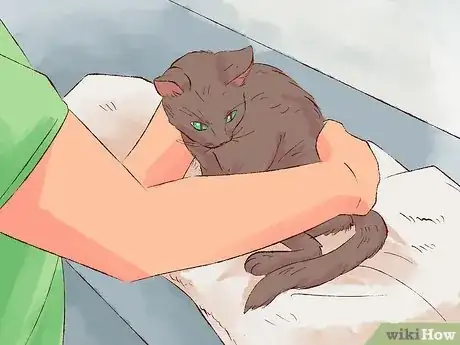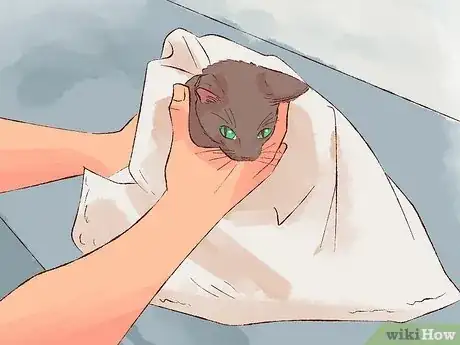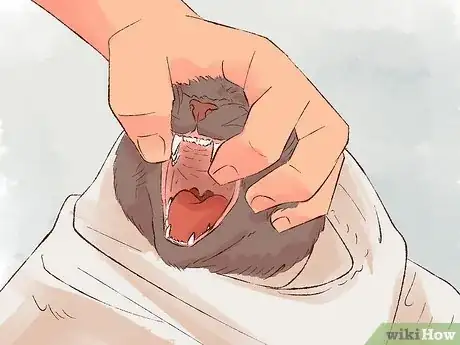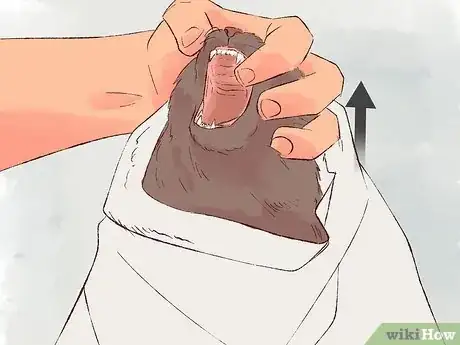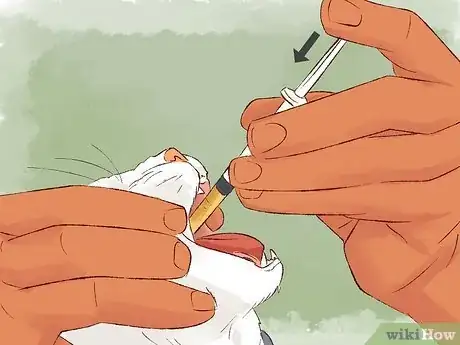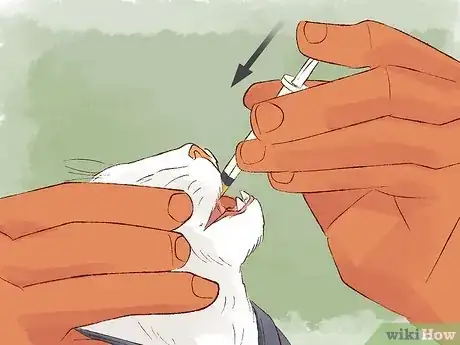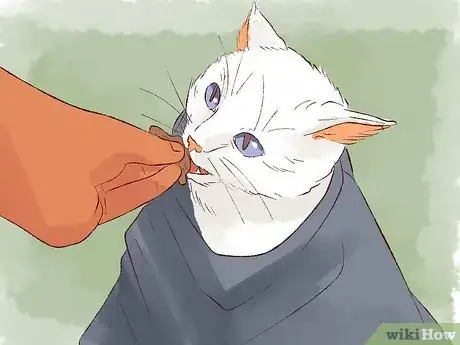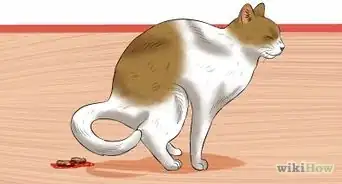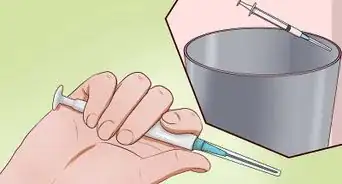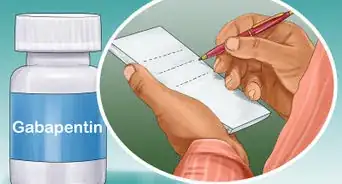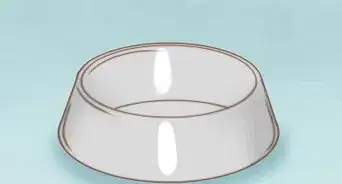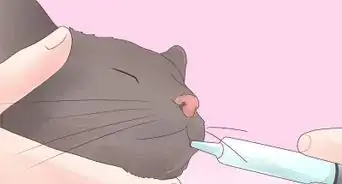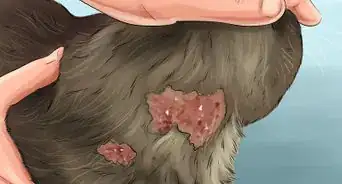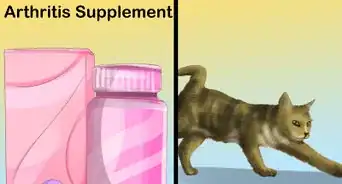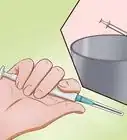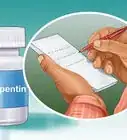This article was co-authored by Natalie Punt, DVM. Dr. Natalie Punt is a Veterinarian and the Founder and CEO of mPet- a smart phone app for pet owners to store, manage and transfer their pets medical records and health information. She specializes in small animal emergency and general medicine and veterinary practice economics. Dr. Punt holds a BS in Biochemistry and Molecular Biology from The University of California, Davis, an MS in Biochemistry from The University at Buffalo, and a DVM from Western University of Health Sciences.
wikiHow marks an article as reader-approved once it receives enough positive feedback. This article received 11 testimonials and 87% of readers who voted found it helpful, earning it our reader-approved status.
This article has been viewed 260,337 times.
Medications for cats come in different formulations, such as tablets, capsules, spot-on formulations, and oral liquids. Cats tend to struggle and resist having things forced into their mouths, with the syringe used to administer medications being no exception. However, with a bit of preparation and by following a few simple tips, giving your cat a liquid medication need not be stressful.
Things You Should Know
- Immobilize your cat, open its mouth, and lift its mouth up so that its ready to receive medicine.
- Place the medicine-filled syringe into the cat's mouth before gently and slowly pressing the syringe's plunger.
- Give the cat about half a millimeter of medicine at a time so it's able to swallow, pause, and keep repeating this process until the cat has received all of the medicine.
Steps
Preparing your Cat
-
1Position your cat. Gently carry your cat to your dosing area (i.e. the towel) and make sure your voice is soothing, happy, and relaxed. Place the cat in the middle of the towel, facing you.
-
2Immobilize the cat. At this point, you will need to ensure that the cat cannot wiggle or escape during the dosing.
- If your cat is very placid, it may be sufficient to hold it. If you have an assistant, he or she should place a hand on each of the cat's shoulders and gently grips the cat's upper forelegs. This keeps the cat still and stops it from lifting a front paw to scratch.[1]
- You or the assistant can also cuddle the cat to your chest or stomach, to stop the cat backing away or wriggling sideways.[2]
- If your cat is wiggly or likely to scratch you, you'll need to wrap the cat in the towel. Wrap your feline snugly, with just its head protruding. A snug fit around the neck ensures the claws are safely contained inside and cannot scratch you.[3]
- To do this, fold one half of the towel over the cat's back and repeat with the opposite half so that the cat is contained within the towel. Take up any slack in the towel around its neck, so that its front legs are pinned against its body and contained within the towel.
- If you have an assistant, have him or her put their hands on the outside of the towel, over the cat's shoulders, to steady the animal.
Advertisement -
3Open the cat's mouth. Form an inverted "C" shape with the forefinger and thumb of your left hand. Place this upside-down C over the cat's head. Your fingertip and thumb should be resting on either side of the corner of its mouth, with your palm resting on the cat's forehead. Gently press inwards with the fingertip and thumb, pressing the cat's upper lips over its upper cheek teeth (the molars).[4]
- If you are left-handed, use your right hand to open the cat's mouth so your left hand is free to administer the medication.
- This approach forces the cat to open its mouth slightly in order to avoid biting its own lip, while also minimizing the likelihood that you will be bitten.
-
4Raise the cat's head. Once the cat has opened its mouth a little, angle its head upwards towards the ceiling.[5]
- This can be done without shifting your left-hand grip, simply by rotating your wrist. Tipping its head upwards helps the lower jaw to drop down a little, opening the mouth wider.
Administering the Medication
-
1Place the syringe in the cat's mouth. Pick up the syringe in your free hand and rest the hub of the syringe (the open end) just behind the cat's lower fangs (the long teeth at the front of the lower jaw), angled over the tongue.[6]
- Ideally, the end of the syringe should be able to touch the cat's molars.[7]
-
2Begin administering the medicine. Gently and slowly press the syringe's plunger so that about half a milliliter of fluid is dribbled into the cat's mouth.[8] [9]
- Once you have put medicine in the cat's mouth, it will move its tongue and try to swallow.
- Some cats like to lower their head to swallow, so you may need to relax your wrist so that her head can drop down to a more natural position for swallowing.[10]
-
3Finish dosing the medicine. After the cat has had a chance to swallow, give it another half milliliter of medicine.
- Repeat this process until you have administered the full prescribed dose.
-
4Reward the cat. Talk soothingly to the cat as you slowly unwrap the towel. Most likely, the cat will run off as soon is it can, but if it doesn't give it some affection and maybe a tasty treat.
- Rewarding the cat after giving it medicine will make it less resentful and make the task easier next time.
Expert Q&A
-
QuestionCan liquid medicine for cats be mixed with wet food?
 Melissa Nelson, DVM, PhDDr. Nelson is a Veterinarian who specializes in Companion and Large Animal Medicine in Minnesota, where she has over 18 years of experience as a veterinarian in a rural clinic. She received her Doctor of Veterinary Medicine from the University of Minnesota in 1998.
Melissa Nelson, DVM, PhDDr. Nelson is a Veterinarian who specializes in Companion and Large Animal Medicine in Minnesota, where she has over 18 years of experience as a veterinarian in a rural clinic. She received her Doctor of Veterinary Medicine from the University of Minnesota in 1998.
Veterinarian Generally yes, but check with your veterinarian to make sure that it's OK to do first. Keep in mind that most cats can tell if medicine is mixed in their food, and may refuse to eat it.
Generally yes, but check with your veterinarian to make sure that it's OK to do first. Keep in mind that most cats can tell if medicine is mixed in their food, and may refuse to eat it. -
QuestionHow do I get my cat to open his mouth?
 Melissa Nelson, DVM, PhDDr. Nelson is a Veterinarian who specializes in Companion and Large Animal Medicine in Minnesota, where she has over 18 years of experience as a veterinarian in a rural clinic. She received her Doctor of Veterinary Medicine from the University of Minnesota in 1998.
Melissa Nelson, DVM, PhDDr. Nelson is a Veterinarian who specializes in Companion and Large Animal Medicine in Minnesota, where she has over 18 years of experience as a veterinarian in a rural clinic. She received her Doctor of Veterinary Medicine from the University of Minnesota in 1998.
Veterinarian You can gently press both sides of the mouth near where the jaws meet with your fingers to make the cat open its mouth.
You can gently press both sides of the mouth near where the jaws meet with your fingers to make the cat open its mouth. -
QuestionHow do you give a cat a pill?
 Melissa Nelson, DVM, PhDDr. Nelson is a Veterinarian who specializes in Companion and Large Animal Medicine in Minnesota, where she has over 18 years of experience as a veterinarian in a rural clinic. She received her Doctor of Veterinary Medicine from the University of Minnesota in 1998.
Melissa Nelson, DVM, PhDDr. Nelson is a Veterinarian who specializes in Companion and Large Animal Medicine in Minnesota, where she has over 18 years of experience as a veterinarian in a rural clinic. She received her Doctor of Veterinary Medicine from the University of Minnesota in 1998.
Veterinarian Securely hold the cat in your lap, open its mouth and place the pill in the back of the mouth.
Securely hold the cat in your lap, open its mouth and place the pill in the back of the mouth.
Warnings
- Never give your cat more medication than your veterinarian has instructed.⧼thumbs_response⧽
- Avoid placing your finger directly between your cat's teeth, as this greatly increases the risk of being bitten.⧼thumbs_response⧽
- Be patient and administer the medication slowly. Squirting a liquid in quickly can result in the cat inhaling the liquid, which can cause a potentially serious form of pneumonia.[11]⧼thumbs_response⧽
- If your cat is prescribed tablets, always check with your veterinarian before crushing them to make up a liquid. Some tablets are designed to slow-release the active ingredient or are in a protective coating to survive stomach acid and become active in the intestine. Crushing or grinding such tablets decreases their effectiveness and should be avoided.[12]⧼thumbs_response⧽
References
- ↑ BSAVA Textbook of Veterinary Nursing. Cooper and Mullineux. BSAVA Publications
- ↑ BSAVA Textbook of Veterinary Nursing. Cooper and Mullineux. BSAVA Publications
- ↑ BSAVA Textbook of Veterinary Nursing. Cooper and Mullineux. BSAVA Publications
- ↑ Jones' Animal Nursing. Jones. Publisher: Pergamon Press. 5th edition
- ↑ Jones' Animal Nursing. Jones. Publisher: Pergamon Press. 5th edition
- ↑ BSAVA Textbook of Veterinary Nursing. Cooper and Mullineux. BSAVA Publications
- ↑ Natalie Punt, DVM. Veterinarian. Expert Interview. 14 September 2021.
- ↑ BSAVA Textbook of Veterinary Nursing. Cooper and Mullineux. BSAVA Publications
- ↑ Natalie Punt, DVM. Veterinarian. Expert Interview. 14 September 2021.
About This Article
To give your cat liquid medicine, start by wrapping a towel around its body so that it can’t wiggle or escape as you give it the medication. Then, open you cat’s mouth by gently pressing on the sides of its mouth with your thumb and forefinger. Next, angle its head back, place the tip of the syringe right behind your cat's lower fangs, and squeeze out about half a millimeter of the medicine. Once your cat swallows, squeeze out another half millimeter and continue the process until you’ve administered the full dose. For more advice from our Veterinary co-author, including how to prepare the medication before giving it to your cat, keep reading!
